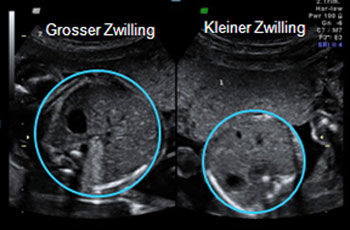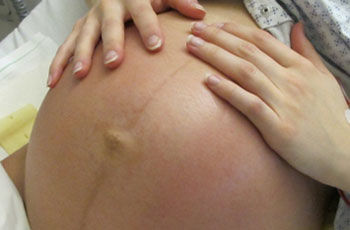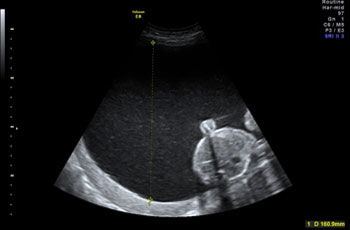Twin pregnancy problems
Problem
In twin pregnancies problems are most likely to arise if the twin fetuses share a common placenta and thus share their supply of nutrients.
A common placenta has vascular connections (1) through which blood can pass between the twin fetuses. If the blood flow is unbalanced, one fetus may receive too much blood, and the other too little (“feto-fetal transfusion syndrome” or “twin-to-twin transfusion syndrome”). As a result, both fetuses may die. Where the placental area is unevenly distributed between the two fetuses, one fetus may be markedly smaller than the other (2) and eventually stop growing.
Diagnosis
Uneven blood distribution between twin fetuses sharing a common placenta can be detected by ultrasound on the basis that one fetus produces too much amniotic fluid (1), and the other too little or ultimately none (2). Measurements of blood flow, e.g. in the umbilical cord, are required in order to assess the condition of the fetuses more precisely.
Affected women often notice a rapid increase in the size of their abdomen (3). This may be accompanied by lower abdominal and back pain and also by difficulty in lying down and shortness of breath.
Therapy
In a fetal endoscopic procedure the vascular connections between the fetuses that are present in the placenta can be obliterated by laser coagulation (1). This stops blood flowing between the fetuses and separates areas of the placenta so that each fetus has its own share. Respiratory movements of the mother during the operation can make the laser treatment difficult (2). Rarely, e.g. in the case of an isolated non-survivable malformation of one of a pair of twins with a common placenta, endoscopy may have to be used to close the umbilical cord. Fetal endoscopy can also be used to sever amniotic bands that may interfere with the development of one or both twins.
Outcome
The probability that at least one of the twins will survive is 80–90% after laser therapy.
Depending on the severity of the condition, the distribution of placental area between the two fetuses, and the success of the operation, both fetuses can be expected to survive in about 50% of cases. The main complication of the operation is premature rupture of the membranes with resulting premature birth and its attendant complications.











